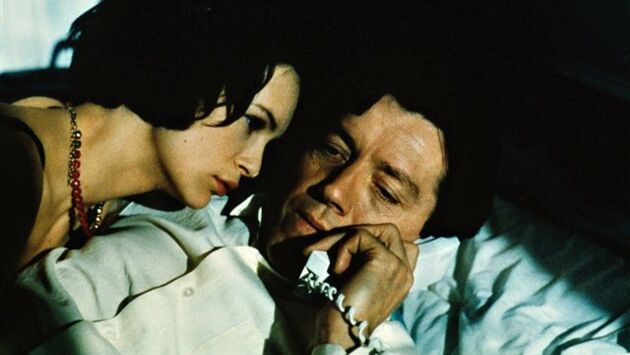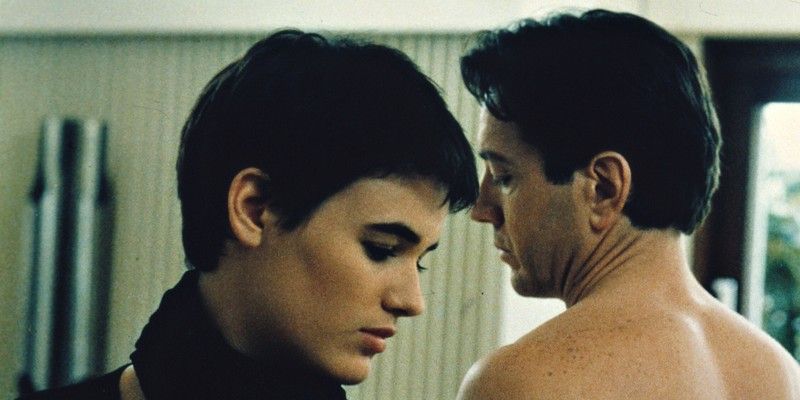Against the Story
A New Life by Olivier Assayas

Feature films are documentaries of emotional life. They can capture the typical mood of a time like no other technique. Great films do this not in an identifying but in an objectifying way; they are documentaries disguised as fiction and story. A fourth feature film by Olivier Assayas is on in our cinemas: A New Life (featuring Sophie Aubry, Judith Godrèche and Bernard Giraudeau). Once again, he shows a couple of young heroes revealing the wounds of the spirit of the time. Assayas films them as a mirror for our self-portrait.
The film – like those of Rossellini or Godard – is conceived as a dangerous experiment. Subtle doses of procedures in which one risks it all: only in this way can one show the presence of a previously non-existing feeling. Assayas does not illustrate, he demonstrates.
Olivier Assayas loves stories and telling them. This son of the nineteenth-century novel is a most natural master of following one figure in a vast social network. In it, a social ascent, in which infidelity, cruelty and aggression are steps towards an ever deeper “negative insight” (a lack of insight rather than insight into the negative). Here, no moral pedagogy is possible without a social trajectory. (Conversely, American film culture is the child of the anti-novel, the short story, in which a minor incident reveals an entire implicit and therefore in fact already known reality. Changing insight is out of order here. The short story operates photographically, with a flash; the European narrative tradition operates stereoscopically, with shifting depth proportions).
Assayas loves telling stories but at the same time distrusts the narrative machine. The banalities committed in the name of the pact between psychology and sociology make him cautious. The Nouvelle Vague had warned against this so very lucidly. Before you realise, the story drives you to the poorest of moral orthodoxies. No, he wants to describe, not to recruit sympathy by presenting something sympathetically. On the contrary, you must generate a certain resentment towards your character and his situations: but that, of course, is fatal for the contract with the moviegoer. In its place comes a permanent negotiation between the director and the audience.
Olivier Assayas loves acting (that’s where the essential negotiation between repulsion and attraction occurs). He places his actors and actresses in the image with trembling admiration. That image is especially determined temporally: long shots that are never slow because they are enormously agile (steadycam). In a nearly coquettish way, he lets us look over the images’ shoulders at their “manner of behaving”.
Acting happens in the shot, not between the shots. Assayas edits as little as possible and does not construct the acting effect from beautiful fragmentary acting details edited together as fluidly as possible. No, he observes the acting in its unmanipulated continuity. This has profound implications for the construction of the film.
Assayas ultimately cares far more about the fate of a shot than the success of a scene. It’s precisely this predominance of the shot that’s always been the hallmark of modern cinema, from Rossellini to Godard, from Pasolini to Fassbinder.
Assayas combines this fascination with the shot (and the acting in it) with his resentment towards storytelling (and his lust for it). He cuts off scenes abruptly but does capture in each shot the most explosive energy of the acting. He replaces the normal buildup and completion of that energy in a scene with brutal ellipses and jarring shortcuts. Something similar happens in the story, which he gives breadth and depth but from which he removes the motivations. Take two powerful side characters (each seen in one scene): Tina’s father and mother. No scene-building, no psychological foundation: in virtuoso fashion, Assayas establishes closed, because unmotivated, character-blocks, with no excuses for their doings. Which is precisely the reason they are so unforgettable!
What seems to bother Assayas in the story is the directionality intrinsic to any narrative. One must always end up somewhere. How to prevent the targeted point (the end, the lesson, the explanation) from doing the fatal work of a narrative telos, a reason for the imaginary world? How to tell a story without steering it? He turns his resentment towards his own desire for storytelling into the essence of his style: no filled-in setting, no nicely built-up and completed temporality, but always the sustained breath of the shooting: long and agile shots, wonderfully complex, breathtaking energies unleashed from simple displacements.
All this serves an unerringly sharp study of contemporary emotional style. With a radically romantic eye, Assayas analyses an endless chain of “crimes contre l’amour” [crimes against love]: an exasperating succession of rejections, break-ups, betrayals and violence. Time and again, the characters come upon an instrumental sexuality that is the necessary yet completely blocked path to the grail of trust. In that hellish desperation, Bresson often sought out his young characters; in this, Assayas is very much alike. To get that point on the screen, though, he must find means to break the anecdote, to shame the gossiping curiosity, to make characters that one can empathize with and that are also radically inaccessible. He is not a clear-cut director of alienation but, on the contrary, a director of frustration: making identification possible and at the same time superfluous.

Images from Une nouvelle vie (Olivier Assayas, 1993)
This text originally appeared in Kunst & Cultuur 27, April 1994.
Many thanks to Reinhilde Weyns and Bart Meuleman
With support from LUCA School of Arts, LUCA.breakoutproject

